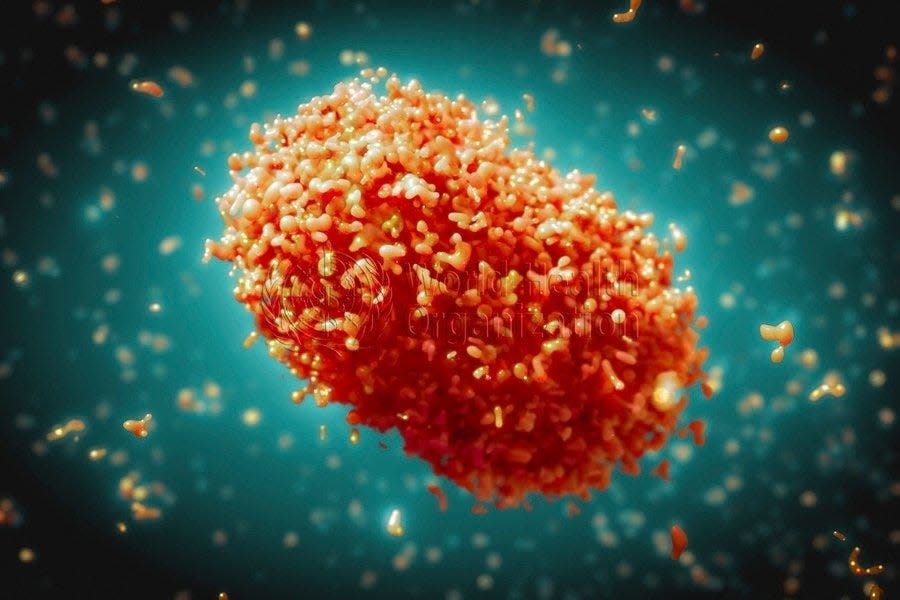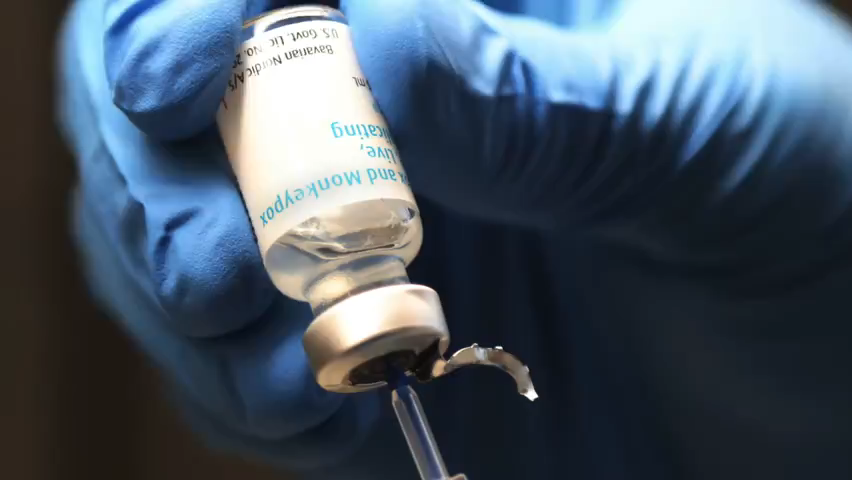Monkeypox cases continue to rise in Austin as COVID-19 cases dip slightly
Monkeypox cases continue to rise in the Austin area, even as local COVID-19 cases have seen a slight decline, according to health care officials.
There are now nine confirmed cases and 46 presumed cases of monkeypox in the Austin area. A confirmed case is one that has been verified by the U.S. Centers for Disease Control and Prevention, while a presumed cased is in a person who has tested positive but not had their case confirmed by the CDC.
The confirmed cases have stayed the same for the third week, awaiting the CDC's confirmation, but the presumed cases have grown from nine to 46 in recent weeks.
Austin Public Health officials say they expect those numbers to grow. The agency has 60 tests it is waiting for results on and 256 people it is monitoring because they have had exposures. Of the tests it has sent out, 80% are coming back positive, said Dr. Desmar Walkes, Austin-Travis County health authority.
There have been 6,616 cases of monkeypox in the United States and 527 in Texas, but CDC officials say the number of cases is likely underreported.
Austin area health officials on Friday hosted a virtual roundtable to provide information about monkeypox. The event was hosted by Central Health and can be viewed on Central Health's Facebook page.
"This is something we don't have to be reactive to," said Adrienne Sturrup, director of Austin Public Health. "We have the upper hand."
She pointed to what Travis County was able to do in mitigating the spread of COVID-19 compared with other major cities. "Let's take that same power. Let's have the conversations," Sturrup said.
"There is a lot of fear about monkeypox," said Dr. Aliza Norwood of Vivent Health. "This information is not getting out as broadly as we want, and there is a lot of misinformation."
How monkeypox can spread
Unlike COVID-19, monkeypox typically requires prolonged physical contact with a person to spread, rather than spreading through the air.
"Over 99% of the cases have been seen through prolonged physical contact," Norwood said, such as cuddling, kissing or having sex.
Monkeypox has been around for about 50 years, but experts don't know why it has spread globally rather than staying in Africa, where it usually is found. "We are still learning from this disease," Norwood said.
Monkeypox spreads in these ways:
Direct contact with the infectious rash, scabs or bodily fluids.
Respiratory secretions with face-to-face contact during activities such as kissing, cuddling or sex.
Touching items such as clothing or linens that previously touched the infectious rash or body fluids.
Pregnant people can spread the virus to their fetus through the placenta.
The outbreak has disproportionately affected men who have sex with other men, but anyone can get it. This monkeypox outbreak has reminded providers of what happened when HIV first began and the stigma around that virus.
"We're going to do everything we can to prevent stigma going forward," Walkes said.

What are monkeypox's symptoms?
Symptoms of monkeypox can include:
Fever.
Headache.
Muscle aches and backache.
Swollen lymph nodes.
Chills.
Exhaustion.
A rash that can look like pimples or blisters. It can be on the face, inside the mouth and on other parts of the body, like the hands, feet, chest, genitals or anus.
The good news with monkeypox is most people get a less severe form of the disease, medical experts say.
The West African version, which is what we have in the United States, "is a really mild, self-limiting disease," said Dr. Kristin Mondy, chief of the division of infectious diseases at the University of Texas Dell Medical School.
With the West African version, there is less than 1% mortality, she said.
The disease, though, can be very painful. A few people locally have had to be hospitalized for pain control, Walkes said.
People at risk for severe cases of the disease include:
People who are already immune-compromised. This includes people who have HIV.
Children younger than 8. (In the U.S. there have been two pediatric cases.)
Pregnant women can pass the disease to their fetuses and could be at risk miscarriage.
People who have the disease, touch their rash and then touch other areas of their body. They could create multiple rash sites.
With school starting, parents and children do not need to be afraid of getting monkeypox by playing sports or going to school.
"We need to allow our children to be children," Walkes said. She is urging people to screen themselves. If they have a fever, stay home. If they develop a rash, stay home and call the doctor.

Getting vaccinated or tested for monkeypox
There is a vaccine for monkeypox. As of last week, Austin Public Health had 3,000 doses of the two-dose vaccine and continues to ask for more. It is prioritizing those doses for people who have come in contact with someone infected with monkeypox in the last 14 days or someone who has multiple sexual partners in the last 14 days with people in and around a high area of cases. People can call Austin Public Health's equity line, 512-972-5560, for information on vaccination.
With the White House declaring monkeypox a public health emergency, more resources will become available, including more vaccine doses. However, the vaccine is made in Denmark and bigger shipments are not expected to reach the U.S. until September, Sturrup said.
If needed, Sturrup said, Austin Public Health can set up testing sites and vaccination sites as more vaccine doses become available. Testing, though, will not be like the drive-thru nose swabs for COVID-19.
Monkeypox is not related to chickenpox, so the chickenpox vaccine will not give you monkeypox protection.
The course of monkeypox
Monkeypox can take up to 21 days before symptoms surface, the CDC said. Usually other symptoms, such as a fever, happen before the rash appears one or two days later.
If you need a test for monkeypox, you can call that same equity line or see a health care provider. You can only get tested if you have a rash because the test involves taking a swab of a sore.
While you are waiting for the results of the test, you should isolate, including from other people in your home. You should wear a mask and do your own laundry, if possible. You should use a separate bathroom if possible or clean it in between uses. You should isolate from pets because it can be spread to pets.
If you test positive for monkeypox, you can be contagious for between two and four weeks, according to the CDC.
"This can be very isolating," said Dr. Michael C. Stefanowicz of CommUnityCare, who has been treating people with the disease.
What you need to know about monkeypox:Cases rise in Austin area; health officials call on community to help fight spread
COVID-19 declining slightly
Travis, Williamson and Bastrop counties continue to stay in the medium level for COVID-19 spread, according to the CDC. Caldwell and Hays counties have now returned to medium level after spending July in the high level. The difference between the two county groups has not been a big difference in transmission rate (number of cases per 100,000 people); it's been the number of new patients admitted to the hospital with COVID-19 and the percentage of hospital beds taken by people with COVID-19.
In Travis County this week, the transmission rate fell from 265.16 to 249.62. In Williamson County the transmission rate dropped to 297.69 from 331.55. In Bastrop County, the transmission rate is now 344.89, up from 304.32 last week.
In Travis, Williamson and Hays counties, the new hospital admissions with COVID-19 per 100,000 people fell to 9.4 from 9.7 and the percentage of hospital beds taken by people with COVID-19 fell to 4.6% from 5.3%. If the new admission rate went to 10 or the percentage of beds reached above 10%, these counties would be considered at the high transmission rate.
In Caldwell and Hays counties, the number of new admissions to hospitals with COVID-19 fell to 9.5 from 13.5 per 100,000 people last week, but the percentage of staffed hospital beds in use by COVID-19 patients has risen to 9.7% from 8.6%. That new admissions number is what returned these counties to the medium level
The transmission rate in Hays County was 379.68 down from 394.02 last week. In Caldwell County, the transmission rate was 480.95, up from 476.35 last week.
The counties' transmission rates count only cases that have been recorded through clinics, pharmacies and health departments, not cases confirmed by home tests.
This article originally appeared on Austin American-Statesman: Austin monkeypox cases rise as COVID-19 numbers dip slightly

